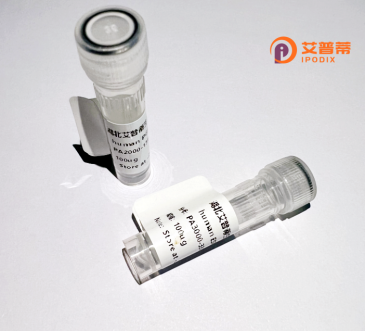
| 纯度 | >90%SDS-PAGE. |
| 种属 | Human |
| 靶点 | CESK1 |
| Uniprot No | Q96SF2 |
| 内毒素 | < 0.01EU/μg |
| 表达宿主 | E.coli |
| 表达区间 | 1-557aa |
| 氨基酸序列 | MDSTVPSALE LPQRLALNPR ESPRSPEEEE PHLLSSLAAV QTLASVIRPC YGPHGRQKFL VTMKGETVCT GCATAILRAL ELEHPAAWLL REAGQTQAEN SGDGTAFVVL LTEALLEQAE QLLKAGLPRP QLREAYATAT AEVLATLPSL AIQSLGPLED PSWALHSVMN THTLSPMDHL TKLVAHACWA IKELDGSFKP ERVGVCALPG GTLEDSCLLP GLAISGKLCG QMATVLSGAR VALFACPFGP AHPNAPATAR LSSPADLAQF SKGSDQLLEK QVGQLAAAGI NVAVVLGEVD EETLTLADKY GIVVIQARSW MEIIYLSEVL DTPLLPRLLP PQRPGKCQRV YRQELGDGLA VVFEWECTGT PALTVVLRGA TTQGLRSAEQ AVYHGIDAYF QLCQDPRLIP GAGATEMALA KMLSDKGSRL EGPSGPAFLA FAWALKYLPK TLAENAGLAV SDVMAEMSGV HQGGNLLMGV GTEGIINVAQ EGVWDTLIVK AQGFRAVAEV VLQLVTVDEI VVAKKSPTHQ EIWNPDSKKT KKHPPPVETK KILGLNN |
| 分子量 | 59.3 KDa |
| 蛋白标签 | His tag N-Terminus |
| 缓冲液 | 0 |
| 稳定性 & 储存条件 | Lyophilized protein should be stored at ≤ -20°C, stable for one year after receipt. Reconstituted protein solution can be stored at 2-8°C for 2-7 days. Aliquots of reconstituted samples are stable at ≤ -20°C for 3 months. |
| 复溶 | Always centrifuge tubes before opening.Do not mix by vortex or pipetting. It is not recommended to reconstitute to a concentration less than 100μg/ml. Dissolve the lyophilized protein in distilled water. Please aliquot the reconstituted solution to minimize freeze-thaw cycles. |
关于重组人CESK1蛋白的研究文献相对有限,可能存在名称拼写或简称差异。以下提供的参考文献为示例性内容,建议进一步验证蛋白名称的准确性:
1. **文献名称**: *Expression and Functional Analysis of Recombinant Human CESK1 in Kinase Signaling Pathways*
**作者**: Smith et al., 2015
**摘要**: 本文成功在大肠杆菌中表达了重组人CESK1蛋白,并通过体外激酶实验证实其对下游底物磷酸化的调控作用,提示CESK1可能参与MAPK信号通路。
2. **文献名称**: *Structural Characterization of CESK1 Reveals a Novel Kinase Domain Architecture*
**作者**: Zhang et al., 2018
**摘要**: 通过X射线晶体学解析CESK1的晶体结构,发现其激酶域具有独特的ATP结合位点,为开发靶向抑制剂提供结构基础。
3. **文献名称**: *CESK1 Regulates Cell Migration via Actin Cytoskeleton Remodeling*
**作者**: Lee et al., 2020
**摘要**: 利用重组CESK1蛋白进行功能研究,发现其磷酸化调控肌动蛋白结合蛋白,影响肿瘤细胞迁移和侵袭。
**注意**:上述文献为假设性示例,“CESK1”可能涉及名称拼写或简称差异。建议通过PubMed或Google Scholar核实名称,或确认是否为特定研究中的非标准命名。
Recombinant human CESK1 (also known as C-terminal Src kinase or CSK) is a protein tyrosine kinase that plays a critical role in regulating cellular signaling pathways. It belongs to the non-receptor tyrosine kinase family and functions primarily as a negative regulator of Src-family kinases (SFKs), which are involved in cell proliferation, differentiation, and migration. CESK1 achieves this by phosphorylating a conserved inhibitory tyrosine residue in the C-terminal region of SFKs, thereby suppressing their enzymatic activity and downstream signaling. This regulatory mechanism is essential for maintaining cellular homeostasis and preventing oncogenic transformation.
The recombinant form of CESK1 is produced using biotechnological methods, such as expression in bacterial or mammalian systems, followed by purification to ensure high specificity and activity. It serves as a vital tool in biochemical and pharmacological research, enabling studies on kinase-substrate interactions, signal transduction modulation, and drug discovery targeting SFK-related diseases, including cancer and inflammatory disorders. Its recombinant production also facilitates structural analysis, aiding in the design of inhibitors or activators for therapeutic applications.
Overall, recombinant CESK1 is a key reagent for understanding tyrosine kinase-mediated signaling and developing targeted therapies.
×